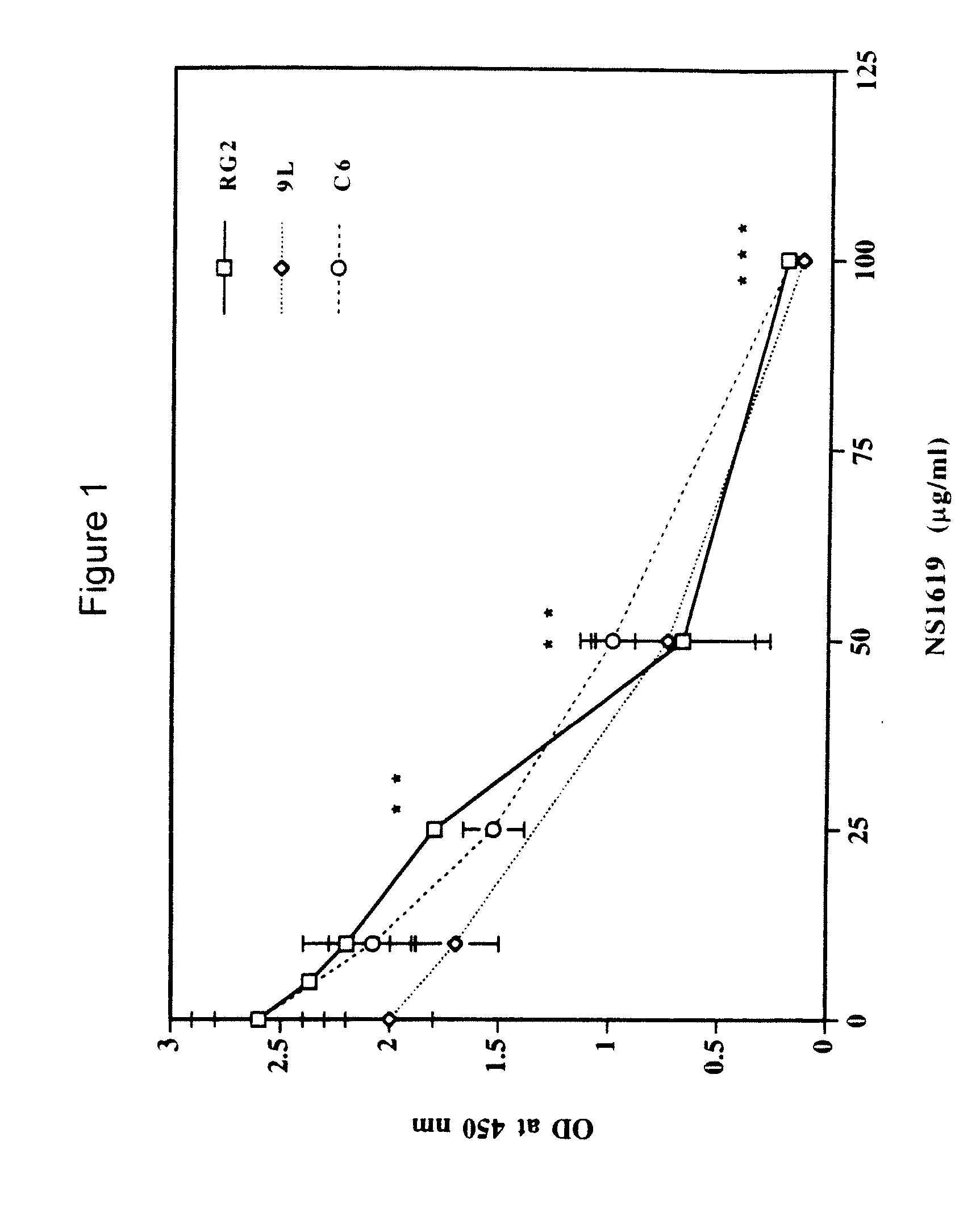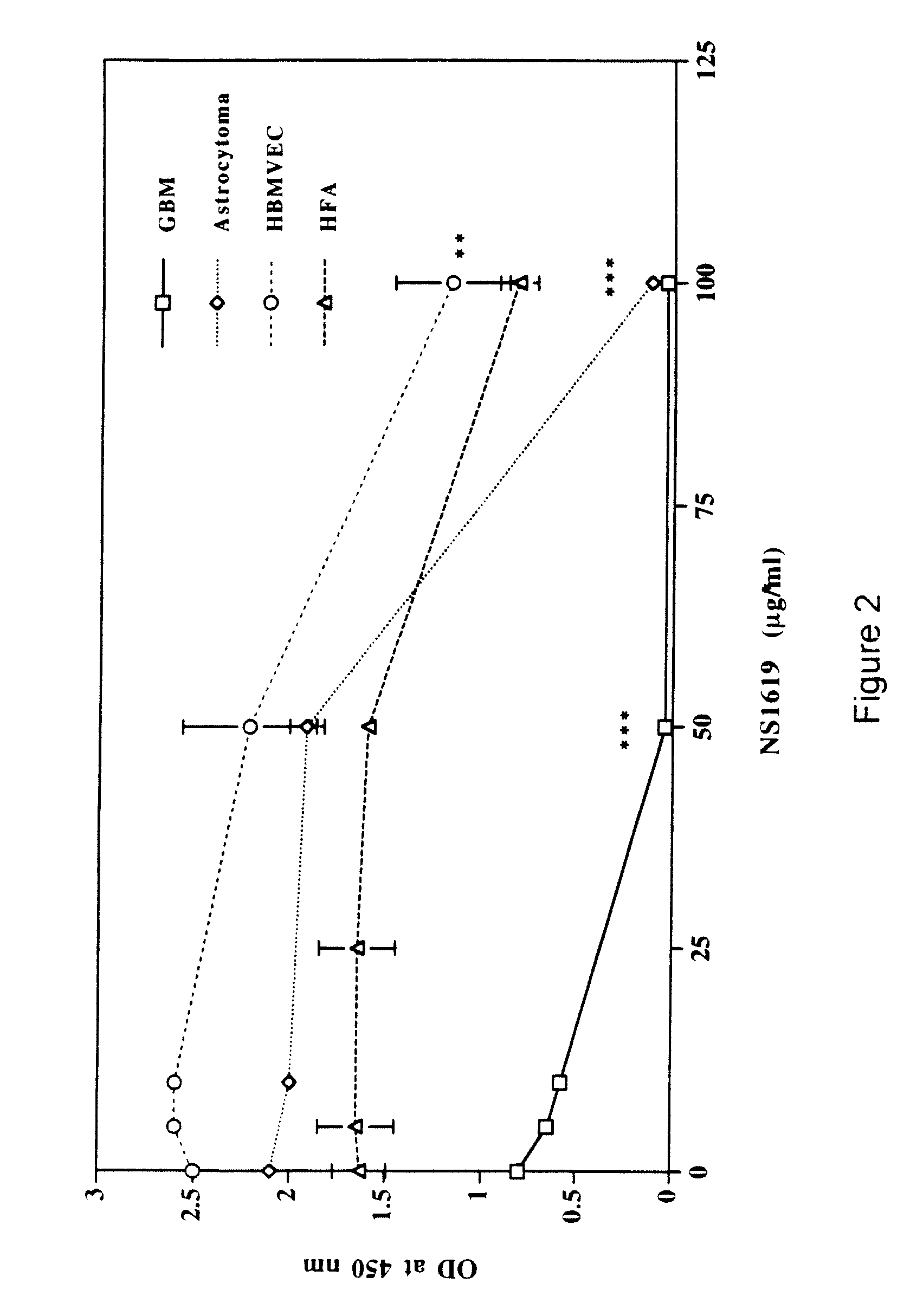Induction of apoptosis of malignant cells by activation of calcium-activated potassium channels
a potassium channel and calcium-activated technology, applied in the field of medical science, can solve the problems of cancerous cells, unable to experience normal cell transduction or apoptosis-driven natural cell death process, and the effect of ksub>ca /sub>channel activation in glioma cell proliferation has not been studied so far
- Summary
- Abstract
- Description
- Claims
- Application Information
AI Technical Summary
Benefits of technology
Problems solved by technology
Method used
Image
Examples
example 1
Methods
[0056] Cells. Primary cell lines were prepared from human gliomas (glioblastoma multiforme [GBM] or astrocytoma) or established rat glioma cell lines (RG2, C6 and 9L) were used. Cultured human normal cell lines, brain microvessel endothelial cells (HBMVEC), or fetal astrocytes were used.
[0057] Cell proliferation assay. Cells (5×104 cells) were cultured in each well of 96-well microtiter culture plates and were allowed to achieve confluency to form a monolayer of cells in each well. For dose response studies cells were incubated with different concentrations (1-100 μg / mL) of NS-1619 or minoxidil sulfate for 4 hours at 37° C. in a CO2 (5%) incubator. Cells washed twice carefully with respective medium, and allowed to incubate overnight at 37° C. under 5% CO2. The following day, cells were incubated with WST-1 reagent (Boehringer Mannheim) at 37° C. in a CO2 (5%) incubator for 60-90 minutes, and optical density at 450 nm was measured with a 96-well plate reader. The magnitude ...
example 2
Results
[0069] Cell proliferation inhibited by KCa activator. Cell proliferation assays were conducted, in vitro, as described herein, with rat glioma cells (RG2, C6 and 9L) or human normal cell lines, brain microvessel endothelial cells (HBMVEC), or fetal astrocytes (HFA). Results showed that KCa activator (NS-1619) significantly blocks cell proliferation selectively in the rat glioma cell lines in a dose-dependent manner (FIG. 1). Similarly, NS-1619 significantly blocked cell proliferation selectively in primary human glioma cell lines (GBM and astrocytoma) in a dose-dependent manner without affecting the normal HBMVEC and HFA cell lines (FIG. 2). All of the rat and human malignant cells studied, as well as normal cells, were insensitive to KATP channel agonist, minoxidil sulfate (data not shown).
[0070]FIG. 3 illustrates that a differential sensitivity to NS-1619 (50 μg / mL) that was observed among rat glioma cell lines RG2, C6, and 9L, with RG2 being most sensitive (70% cell deat...
PUM
| Property | Measurement | Unit |
|---|---|---|
| body mass | aaaaa | aaaaa |
| pH | aaaaa | aaaaa |
| pH | aaaaa | aaaaa |
Abstract
Description
Claims
Application Information
 Login to View More
Login to View More - R&D
- Intellectual Property
- Life Sciences
- Materials
- Tech Scout
- Unparalleled Data Quality
- Higher Quality Content
- 60% Fewer Hallucinations
Browse by: Latest US Patents, China's latest patents, Technical Efficacy Thesaurus, Application Domain, Technology Topic, Popular Technical Reports.
© 2025 PatSnap. All rights reserved.Legal|Privacy policy|Modern Slavery Act Transparency Statement|Sitemap|About US| Contact US: help@patsnap.com



